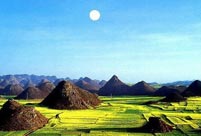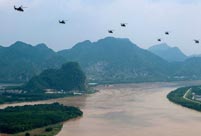

WASHINGTON, June 15 -- A highly unpredictable hot and dry climate prevented large plant-eating dinosaurs from dominating tropical regions near the equator for up to 30 million years after they first evolved, a new research suggested Monday.
Although dinosaurs first appeared about 230 million years ago, large, long-necked, plant-eaters, or sauropodomorphs, were rare in tropical latitudes, with only small-bodied meat-eaters present there during the first 30 million years. Palaeontologists have proposed different theories to explain why this happened.
In the new study, researchers took rock samples from a location called Ghost Ranch, in the U.S. state of New Mexico, where a number of dinosaur fossils have been discovered. The rocks were deposited by rivers and streams between 205 and 215 million years ago, during the Late Triassic Period.
After analysis of the rocks, by crushing the sample and separating isotopes of the elements carbon and oxygen using an electromagnet and counting them with high-precision detectors, the team was able to piece together a detailed picture of the climate and ecology during rise of dinosaurs.
The climate, they found, alternated between wet seasons in some years and extreme droughts in others, and was punctuated by raging wildfires every few dozen years that reached temperatures of up to600 degrees Celsius.
The atmosphere in low latitudes was also very high in carbon dioxide -- four to six times modern levels.
The conditions would have made it difficult for abundant vegetation to grow and survive, vegetation that the Triassic predecessors of more well-known Jurassic sauropods, like Brachiosaurus, Diplodocus and Brontosaurus, would have fed on.
"The conditions would have been something similar to the arid western United States today, although there would have been trees and smaller plants near streams and rivers and forests during humid times," said lead author Jessica Whiteside of the University of Southampton.
The only species able to survive such conditions, according to the researchers, were small two-legged carnivorous dinosaurs, such as Coelophysis.
"Our data suggest it was not a fun place," echoed study co- author Randall Irmis, curator of paleontology at the Natural History Museum of Utah and assistant professor at the University of Utah.
"It was a time of climate extremes that went back and forth unpredictably and large, warm-blooded dinosaurian herbivores weren't able to exist nearer to the equator -- there was not enough dependable plant food."
The researchers said the results will help contribute to an understanding of human-caused climate change.
"Throughout this period, levels of carbon dioxide were four to six times higher than the levels we observe today, but the findings do indicate that if we continue our present course of human-caused climate change, similar conditions could develop and suppress equatorial ecosystems," said Irmis.
The findings were published in the U.S. journal Proceedings of the National Academy of Sciences.
 Abandoned village swallowed by nature
Abandoned village swallowed by nature Graduation: the time to show beauty in strength
Graduation: the time to show beauty in strength School life of students in a military college
School life of students in a military college Top 16 Chinese cities with the best air quality in 2014
Top 16 Chinese cities with the best air quality in 2014 Mysterious “sky road” in Mount Dawagengzha
Mysterious “sky road” in Mount Dawagengzha Students with Weifang Medical University take graduation photos
Students with Weifang Medical University take graduation photos PLA soldiers conduct 10-kilometer long range raid
PLA soldiers conduct 10-kilometer long range raid Stars who aced national exams
Stars who aced national exams
 PLA helicopters travel 2,000 kilometers in maneuver drill
PLA helicopters travel 2,000 kilometers in maneuver drill Hillary’s speech offers clue to Sino-US ties
Hillary’s speech offers clue to Sino-US ties Make me a genius
Make me a genius Weak yen weighing on China’s exports
Weak yen weighing on China’s exportsDay|Week